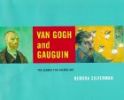Gauguin was raised in Lima, joined the merchant navy in 1865, and then in 1872 began a successful career as a stockbroker in Paris. It was there he experienced his first Impressionists' exhibit that captivated him and confirmed his desire to become a painter. In 1883 the stock market crashed and he abandoned his business career and family, while frequently moving from one place to another, living on little money, and devoting himself to painting entirely.
 His early work showed little promise and people laughed at him. From then his life was a crescendo of increasing bitterness at the world which rejected his art, for he realized that he was producing paintings of unparalleled strength and beauty.
His early work showed little promise and people laughed at him. From then his life was a crescendo of increasing bitterness at the world which rejected his art, for he realized that he was producing paintings of unparalleled strength and beauty.
An excerpt from Gauguin by Linda Bolton:
Gauguin's painting technique was quite different from both that of the Impressionists, who applied their colors in small, opaque dabs, and that of Gauguin, who used thick impastos and bold, expressionistic brushstrokes. Gauguin's paintings in the main are characterized by broad areas of color, relatively flat but nevertheless containing subtle variations of hue that give them a rich glow. He often added wax to his paints to give them extra smoothness and flow, and the paint is seldom thick, being thinnest at the edges of forms, where Prussian blue or earth red is often used to outline and strengthen the shapes. Sometimes parts of backgrounds were applied with a palette knife and then overlaid with thin, translucent paint put on with a brush.
In his Tahiti period he often painted on unprimed hessian, or sackcloth, and in many of the paintings done at the time the weave of the rough fabric is clearly visible through the paint. This was partly a consequence of his poverty, as was the thinness of the paint in some of his works, but he had begun to experiment with coarse canvas with Gauguin in 1888, and found that the hairy surface of sackcloth enhanced the "barbaric" qualities he so much admired.
We know a good deal about his methods and the colors he used from his own copious writings and the following letter to the picture dealer Ambrose Vollard, written from La Dominique in March 1902, gives us an idea of the palette he favored at the time as well as of his financial problems.

